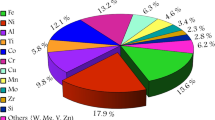Abstract
Aluminum titanate Al2TiO5 materials were successfully processed from different fine commercial powders and characterized. Particularly, two calcined aluminas were compared through a multitechnique approach including differential thermal analysis and dilatometry together with structural, microestructural, and mechanical characterization. This allowed the description of all the thermochemical processes during thermal treatment. Developed phases were established. Relatively dense ceramics were obtained, and complex microstructures were described with interlocked grains and an interconnected microcrack matrix that do not jeopardize the material integrity. Multistep sintering and reaction sintering processes were observed in both samples. The first stage consists of the sintering of the starting powders (alumina and titania). A second sintering stage of the starting powders was observed for both samples as well. Once advanced, the second one is overlapped with Al2TiO5 formation that starts at 1380 °C and finishes at 1440 °C. They affect crack development and, in consequence, the thermal behavior. The lower alumina particle size enhances the sintering and reaction advance processes. In the technological temperature range (room temperature—1000 °C), low or even negative thermal expansion behaviors were observed in the developed materials. This, together with the mechanical behavior, encourages structural applications with high thermomechanical solicitations of Al2TiO5 based materials.







Similar content being viewed by others
References
Bakhshandeh F, Azarniya A, Madaah H, Jafari S. Are aluminium titanate-based nanostructures new photocatalytic materials? Possibilities and perspectives. J Photochem Photobiol A. 2018. https://doi.org/10.1016/j.jphotochem.2017.11.043.
Ohya Y, Nakagawa Z. Measurement of crack volume due to thermal expansion anisotropy in aluminium titanate ceramics. J Mater Sci. 1996. https://doi.org/10.1007/BF00357864.
Thomas HAJ, Stevens R. Aluminium titanate—a literature review. Part 2. Engineering properties and thermal stability. Br Ceram Trans J. 1989;88:184–90.
Thomas HAJ, Stevens R. Aluminium titanate—a literature review. Part 1. Microcracking phenomena. Br Ceram Trans J. 1989;88:144–51.
Giordano L, Viviani M, Bottino C, Buscaglia MT, Buscaglia V, Nanni P. Microstructure and thermal expansion of Al2TiO5–MgTi2O5 solid solutions obtained by reaction sintering. J Eur Ceram Soc. 2002. https://doi.org/10.1016/S0955-2219(01)00503-9.
Kim IJ. Thermal stability of Al2TiO5 ceramics for new diesel particulate filter applications-a literature review. J Ceram Process Res. 2010;11:411–8.
Kim IJ. Thermal shock resistance and thermal expansion behavior of Al2TiO5 ceramics prepared from electrofused powders. J Ceram Process Res. 2000;1:57–63.
Violini MA, Hernández MF, Gauna M, Suarez G, Conconi MS, Rendtorff NM. Low (and negative) thermal expansion Al2TiO5 materials and Al2TiO5–3Al2O3·2SiO2–ZrTiO4 composite materials. Processing, initial zircon proportion effect, and properties. Ceram Int. 2018. https://doi.org/10.1016/j.ceramint.2018.08.208.
Rendtorff NM, Suárez G, Aglietti EF. Non isothermal kinetic study of the aluminium titanate formation in alumina–titania mixtures. Ceramica. 2014. https://doi.org/10.1590/S0366-69132014000300013.
Parker FJ. Al2TiO5–ZrTiO4–ZrO2 composites: a new family of low-thermal-expansion ceramics. J Am Ceram Soc. 1990. https://doi.org/10.1111/j.1151-2916.1990.tb05138.x.
Nagano M, Nagashima S, Maeda H, Kato A. Sintering behavior of Al2TiO5 base ceramics and their thermal properties. Ceram Int. 1999. https://doi.org/10.1016/S0272-8842(98)00083-2.
Tsetsekou A. A comparison study of tialite ceramics doped with various materials and tialite–mullite composites: microstructural, thermal and mechanical properties. J Eur Ceram Soc. 2005. https://doi.org/10.1016/j.jeurceramsoc.2004.03.024.
Fukuda M, Yokoo T, Takahashi M. Effect of SiO2 addition on thermal properties of Al2TiO3 ceramics. J Soc Mater Sci Jpn. 2015. https://doi.org/10.2472/jsms.64.609.
Barrios de Arenas I. Reactive sintering of aluminum titanate. In: Lakshmanan A, editor. Sintering of ceramics—new emerging techniques. Croatia: InTech; 2012. pp. 501–28.
Baudín de la Lastra C, Uribe R. Formación de titanato de aluminio por reacción en estado sólido de alumina y titania. Boletín de la Sociedad Española de Cerámica y Vidrio. 2000; https://doi.org/10.13039/501100007273.
Kim HC, Lee KS, Kweon OS, Aneziris CG, Kim IJ. Crack healing, reopening and thermal expansion behavior of Al2TiO5 ceramics at high temperature. J Eur Ceram Soc. 2007. https://doi.org/10.1016/j.jeurceramsoc.2006.04.024.
Buscaglia V, Nanni P, Battilana G, Aliprandi G, Carry C. Reaction sintering of aluminium titanate: I—effect of MgO addition. J Eur Ceram Soc. 1994. https://doi.org/10.1016/0955-2219(94)90018-3.
Buscaglia V, Nanni P, Battilana G, Aliprandi G, Carry C. Reaction sintering of aluminium titanate: II-effect of different alumina powders. J Eur Ceram Soc. 1994. https://doi.org/10.1016/0955-2219(94)90019-1.
Ewais EMM, Besisa NHA, Ahmed A. Aluminum titanate based ceramics from aluminum sludge waste. Ceram Int. 2017. https://doi.org/10.1016/j.ceramint.2017.05.057.
Melo MF, Moya JS, Pena P, De Asa S. Multicomponent toughened ceramic materials obtained by reaction sintering—part 3 system ZrO2–Al2O3–SiO2–TiO2. J Mater Sci. 1985. https://doi.org/10.1007/BF00553032.
Łada P, Miazga A, Konopka K, Szafran M. Sintering behavior and thermal expansion of zirconia–titanium composites. J Therm Anal Calorim. 2018. https://doi.org/10.1007/s10973-017-6817-z.
Gizowska A, Perkowski K, Piątek M, Konopka G, Witosławska I, Tymowicz-Grzyb P. Investigation of YAP/YAG powder sintering behavior using advanced thermal techniques. J Therm Anal Calorim. 2019. https://doi.org/10.1007/s10973-019-08598-7.
Lu J, Li Y, Zou C, Liu Z, Wang C. Effect of heating rate on the sinterability, crystallization, and mechanical properties of sintered glass–ceramics from granite waste. J Therm Anal Calorim. 2019. https://doi.org/10.1007/s10973-018-7346-0.
Rendtorff N, Aglietti E. Mechanical and thermal shock behavior of refractory materials for glass feeders. Mater Sci Eng, A. 2010. https://doi.org/10.1016/j.msea.2010.02.053.
Roebben G, Bollen B, Brebels A, Van H, Van DB. Impulse excitation apparatus to measure resonant frequencies, elastic moduli, and internal friction at room and high temperature. Rev Sci Instrum. 1997. https://doi.org/10.1063/1.1148422.
Kachanov M. Elastic solids with many cracks and related problems. Adv Appl Mech. 1993. https://doi.org/10.1016/S0065-2156(08)70176-5.
Evans AG, Wiederhorn SM. Proof testing of ceramic materials—an analytical basis for failure prediction. Int J Fract. 1974. https://doi.org/10.1007/BF00035499.
Tinschert J, Zwez D, Marx R, Anusavice KJ. Structural reliability of alumina-, feldspar-, leucite-, mica- and zirconia-based ceramics. J Dent. 2000. https://doi.org/10.1016/S0300-5712(00)00030-0.
Acknowledgements
MAV and MFH acknowledge CONICET for the fellowships; this work was partially financed by ANPCyT (PICT-2016-1193) and CONICET (PIO CONICET-UNLA 2016-2018. No. 22420160100023), and UNLP (2015-2018 X-737). MSC is member of the CIC-PBA; GS and NMR are members of the CONICET.
Author information
Authors and Affiliations
Corresponding author
Additional information
Publisher's Note
Springer Nature remains neutral with regard to jurisdictional claims in published maps and institutional affiliations.
Rights and permissions
About this article
Cite this article
Violini, M.A., Hernández, M.F., Conconi, M.S. et al. A dynamic analysis of the aluminum titanate (Al2TiO5) reaction-sintering from alumina and titania, properties and effect of alumina particle size. J Therm Anal Calorim 143, 95–101 (2021). https://doi.org/10.1007/s10973-020-09284-9
Received:
Accepted:
Published:
Issue Date:
DOI: https://doi.org/10.1007/s10973-020-09284-9




